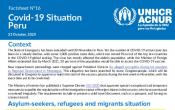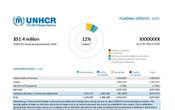Peru
For information on UNHCR's operation in Peru prior to 2019, please see the Regional Office Argentina page.
Operation: Peru
Location
{"longitude":-75,"latitude":-10,"zoom_level":5,"iso_codes":"'PER'"}
By clicking on the icons on the map, additional information is displayed.
The boundaries and names shown and the designations used on this map do not imply official endorsement or acceptance by the United Nations.
Key Figures
| 2019 year-end figures | |
| 48,000 | people received basic relief items, such as water, diapers, toilet paper, energy bars, salty cookies, sunscreen and mosquito repellent |
| 15,000 | Venezuelan refugees and migrants received cash transfers and vouchers to cover their basic needs |
| 11,000 | medical consultations were provided for people of concern in Arequipa, Lima, Puerto Maldonado, Tacna and Tumbes |
| 7,500 | people of concern were reached through six rounds of protection monitoring, which included provision of information and referral to specialized services according to their needs |
| 400 | women, men and children living with HIV were referred to specialized national health services |
| 68 | organizations actively participated in regular meetings of the inter-agency national response for Venezuelans platform |
| 2020 planning figures | |
| >8,370 | vulnerable households will receive multipurpose cash grants |
| >2,000 | monitoring visits will be conducted and reported |
| 15 | reception centres will be improved or maintained |
| 10 | peaceful co-existence projects will be implemented |
More Information
People of Concern
| 2019 | 867,821 |

[["Refugees",2879],["Asylum-seekers",487078],["Venezuelans displaced abroad",377864]]
Loading ...
Peru
< Back
2019
{"categories":[2015,2016,2017,2018,2019,2020],"budget":[null,null,null,null,20.49633232,48.62553417],"expenditure":[null,null,null,null,14.17369775,null]}
{"categories":[2015,2016,2017,2018,2019,2020],"p1":[null,null,null,null,20.49633232,48.62553417],"p2":[null,null,null,null,null,null],"p3":[null,null,null,null,null,null],"p4":[null,null,null,null,null,null]}
{"categories":[2015,2016,2017,2018,2019,2020],"p1":[null,null,null,null,14.17369775,null],"p2":[null,null,null,null,null,null],"p3":[null,null,null,null,null,null],"p4":[null,null,null,null,null,null]}
Loading ...
CHOOSE A YEAR
- 2019
- 2020
Year-end Overview
Operational context
Peru was one of the first countries in the region to introduce an alternative legal pathway for Venezuelans in 2018 - a temporary stay permit (or PTP for its Spanish acronym). The introduction of a humanitarian visa requirement for Venezuelans in June 2019, however, saw an increase in the number of irregular entries in the second part of the year. The procedure to claim asylum at the border was also reviewed, resulting in asylum-seekers waiting up to 30 days at the border for a decision.
While Peru remained an important host country for large numbers of refugees and migrants, negative attitudes towards them were a driving force in public narratives in 2019, impacting the protection space in the country.
While Peru remained an important host country for large numbers of refugees and migrants, negative attitudes towards them were a driving force in public narratives in 2019, impacting the protection space in the country.
Population trends
Peru was host to over 867,800 people of concern, whom were Venezuelan refugees and migrants (67% of whom were women and children) by the end of 2019, making it the second-largest destination country for Venezuelans. It was also the country that had received the highest number of asylum claims from Venezuelans in the world, with a total of almost 487,100 asylum claims having been filed by the end of the year. Only 1,230 Venezuelans were recognized as refugees in 2019.
The country also hosts smaller numbers of asylum-seekers and refugees mostly from Colombia, Cuba, Haiti and Yemen.
By the end of the year, over 432,000 people held a temporary residence permit (PTP) and 133,000 had other migratory permits.
The country also hosts smaller numbers of asylum-seekers and refugees mostly from Colombia, Cuba, Haiti and Yemen.
By the end of the year, over 432,000 people held a temporary residence permit (PTP) and 133,000 had other migratory permits.
Achievements
UNHCR continued responding to the emergency at borders where some 280,000 people received life-saving health care, shelter, basic relief items and cash transfers to meet essential needs.
UNHCR supported the Government to establish a new registration system for asylum-seekers through software, identification cards and additional staff. More than 53,000 asylum-seekers received an identification document, facilitating their access to services.
More than 36,000 Venezuelans received basic information, as well as legal and social counselling, at the Binational Border Centre (CEBAF) in Tumbes and five other orientation centers in Lima.
To foster livelihoods and inclusion, nearly 300 people benefitted from entrepreneurship and vocational trainings, while 200 small businesses received seed capital. UNHCR supported the procedure for recognition of university degrees for some 100 Venezuelan health professionals.
Over 16,000 individuals were reached through social inclusion activities under the #TuCausaEsMiCausa campaign, aimed at mitigating the impact of xenophobia.
UNHCR supported the Government to establish a new registration system for asylum-seekers through software, identification cards and additional staff. More than 53,000 asylum-seekers received an identification document, facilitating their access to services.
More than 36,000 Venezuelans received basic information, as well as legal and social counselling, at the Binational Border Centre (CEBAF) in Tumbes and five other orientation centers in Lima.
To foster livelihoods and inclusion, nearly 300 people benefitted from entrepreneurship and vocational trainings, while 200 small businesses received seed capital. UNHCR supported the procedure for recognition of university degrees for some 100 Venezuelan health professionals.
Over 16,000 individuals were reached through social inclusion activities under the #TuCausaEsMiCausa campaign, aimed at mitigating the impact of xenophobia.
Unmet needs
The operation was funded at 74% by the end of 2019.
As a result of limited funding, only 13% of households in need of assistance received cash transfers or relief items.
Also due to funding shortfalls, UNHCR was unable to support the enrollment of children under 5 in the national education system resulting in increased exposure to negative coping mechanisms and other protection risks. Only 6% of children-at-risk identified by the local authorities received adequate support in alternative childcare facilities.
As a result of limited funding, only 13% of households in need of assistance received cash transfers or relief items.
Also due to funding shortfalls, UNHCR was unable to support the enrollment of children under 5 in the national education system resulting in increased exposure to negative coping mechanisms and other protection risks. Only 6% of children-at-risk identified by the local authorities received adequate support in alternative childcare facilities.
Plan Overview




















